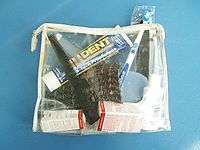Toiletry bag

A body hygiene kit, more commonly known as a toiletry kit (or alternately as a bathroom kit, sponge bag, toilet bag, toilet kit, toiletry bag, travel kit, wash bag, washbag, or wet pack), is a small container, usually a pouch with a zippered opening, which holds body hygiene or toiletry products.
The "kit" is used to provide a single spot where a person's toiletry or hygiene products can be stored. People at home usually have more conventional storage in their bathroom cabinets or counters.
Travelers of all kinds, including backpackers, business or vacation travelers; college students; and youngsters at summer camp all find a "kit" helpful preventing an assortment of small items and containers from disappearing into stray corners of their luggage. It makes it easy to take the items to the restroom or shower room for use.
Overnight kits are similar to body hygiene kits, with the exception that clothing is included and the kits are usually only used for one night.[1]
A body hygiene kit should not be confused with a cosmetic/makeup kit which is intended to restore or improve a person's appearance.[2]
A body hygiene kit specifically for men may be called by the Registered Trademark name Dopp Kit.
Components
- Small bag for packing body hygiene products
- Oral hygiene products
- Cotton swab aka Earbuds
- Deodorant or Antiperspirant
- Nail clippers
- Tweezers
- Soap or Body wash
- Straight or safety razor and shaving cream or electric razor
- Hair brush or comb
- Tampon, sanitary napkin, or menstrual cup
- Sunscreen lotion, spray, or gel
- Contact lenses and contact lens disinfectant solution
- Toilet water (or cologne or perfume)
- Contraception
- Bug dope or repellent
Dopp kit
Dopp kit is a term particularly in use in America for body hygiene kits. The name derives from the early 20th century leather craftsman Charles Doppelt, whose company designed the case in 1919.[3] While the case is named after Doppelt, it appears that the case was actually designed by Doppelt's nephew, Jerome Harris.[4]
The kits became widely known during the Second World War when they were issued to GIs. [5] The Dopp brand name was purchased by Samsonite in the early 1970s, and was later acquired by Buxton in 1979.[6]
The trademark Dopp was filed by Samsonite for registration at the U.S. Trademark Office on Mar. 24, 1980.[7] The class of goods for which it was applicable was “toilet cases sold empty, briefcases, briefcase type portfolios, sample and catalog cases sold empty, luggage identification tags, and traveling bags”. An additional filing for the trademark Dopp Kit was made on April 3, 1980 for the class of goods “travel kits, sold empty”.[8] In both of those applications Samsonite stated that the trademarks were first used in July 1936. The registration for “Dopp Kit” was cancelled in March 2003 when no one filed a required (Section 8) Declaration of Continued Use, but the required declarations have been filed for “Dopp”. The marks were assigned to DHP Limited Partnership (dba Buxton) in 1990; the current owner of the “Dopp” trademark is listed as Buxton Acquisition Co., LLC, of Chicopee, Massachusetts.
Dopp kits were once a common gift given to adolescent males as they ascended from boyhood to adulthood.[9]
References
- ↑ Overnight kit definition
- ↑ Cosmetic kit definition
- ↑ Source: Catalogue from The Guildhall, Davis + Henderson, Markham, Ontario, Canada.
- ↑ Jim Rader (27 Jan 1998). "Etymology discussion on American Dialect". Retrieved 27 Jan 2016.
- ↑ Woolnough, Richard (2008-01-01). The A to Z Book of Menswear. The A to Z Book of Menswear. ISBN 9781897403259.
- ↑ Buxton. "About Us". Retrieved 27 Jan 2016.
- ↑ http://tsdr.uspto.gov Registration number 1193631
- ↑ "Trademark Application "DOPP KIT" (serial #73256578), Registration number 1197268". United States Patent and Trademark Office (USPTO). Retrieved 20 February 2014.
- ↑ ESC (8 March 2005). "Dopp kit". Retrieved 22 September 2015.